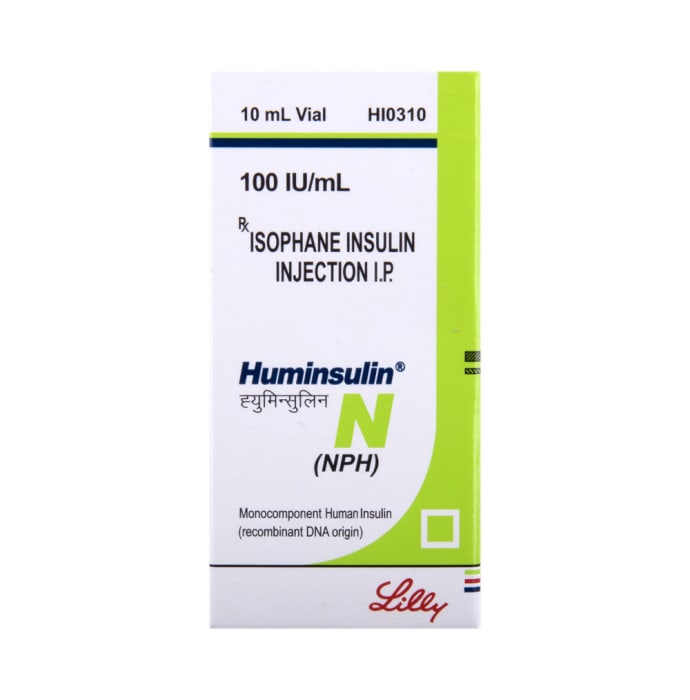
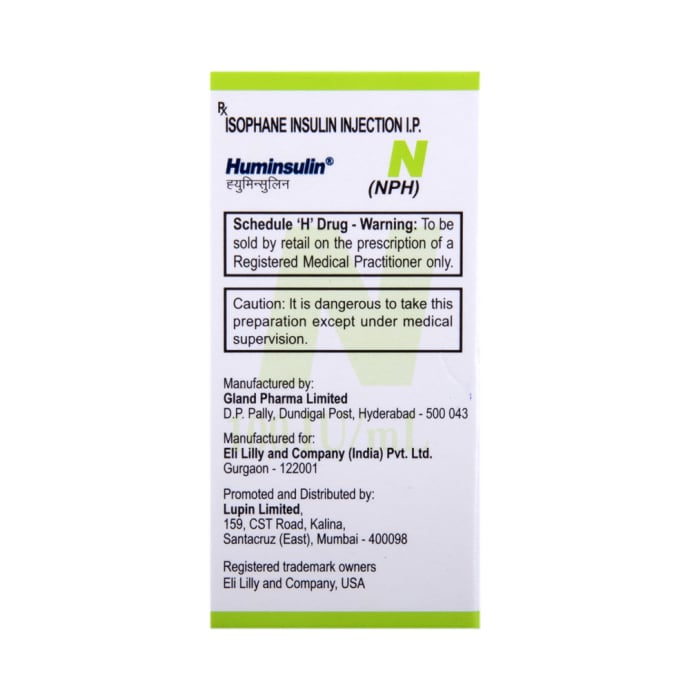
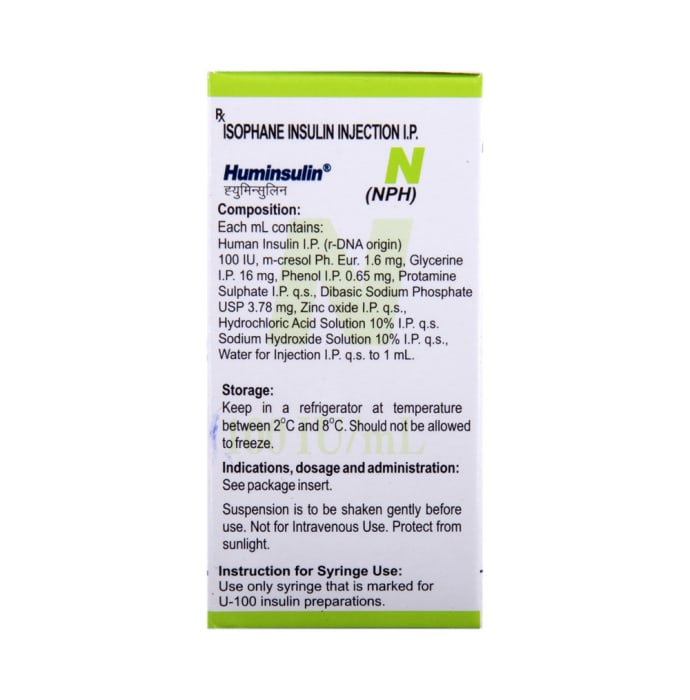
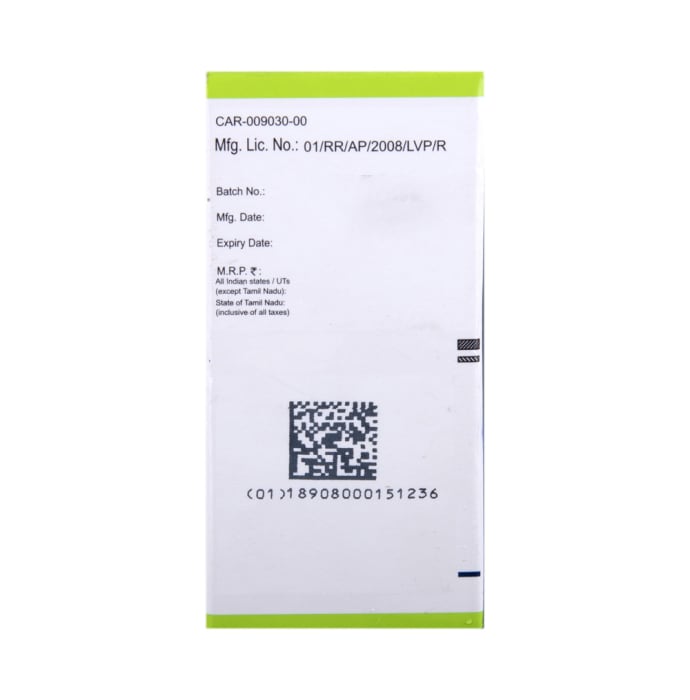
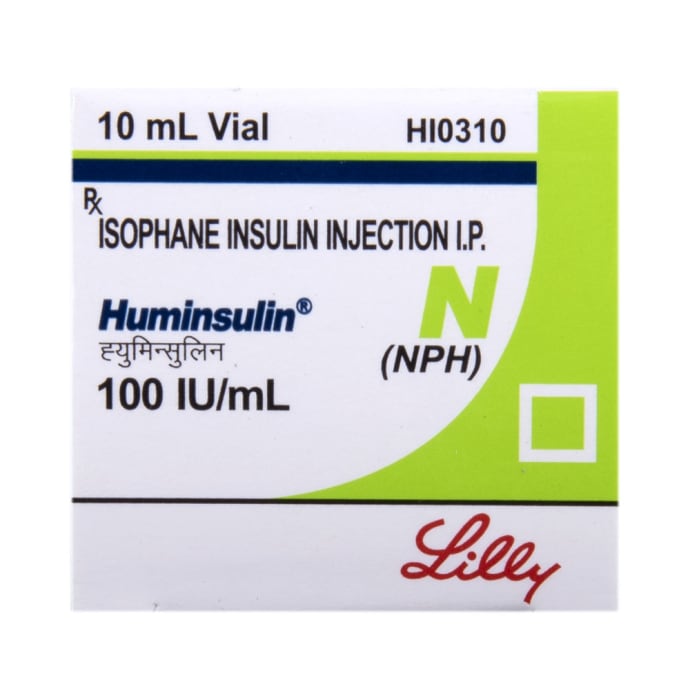
Manufacturer: Eli Lilly and Company India Pvt Ltd
Salt Composition : Insulin Isophane(100IU)
Vial of 10ml Injection
(Inclusive of all taxes)
Huminsulin N 100IU/ml Injection is often prescribed along with short-acting insulin or other oral diabetes medicines. Your doctor or nurse will teach you the correct way of injecting it under the skin. Don’t stop taking it unless your doctor tells you to. It is only part of a treatment program that should also include a healthy diet, regular exercise, and weight reduction as advised by your doctor.
Check your blood sugar levels regularly, keep track of your results and share them with your doctor. This is very important to work out the correct dose of the medicine for you.
The most common side effect of this medicine is low blood sugar levels (hypoglycemia). To prevent this, it's important to always inject the correct dose of medicine only, have regular meals, and monitor your blood sugar levels regularly. Drinking excessive alcohol can also lead to a fall in your blood sugar levels. Other side effects include reactions at the injection site like redness or swelling. Repeated puncturing of the same site of the skin may lead to lipodystrophy (skin thickening or pits at the injection site). Some people may gain weight or develop edema (swelling over the whole body due to fluid retention) while taking insulin.
Do not use this medicine when you have low blood glucose levels (hypoglycemia). Tell your doctor if you have ever had kidney, liver or heart problems before starting treatment. Pregnant or breastfeeding women should also consult their doctor as the dose may need to be changed.
Huminsulin N 100IU/ml Injection is an intermediate-acting insulin, that starts working in 1-2 hours after injection. It works similar to the insulin that is produced by the body. Insulin facilitates reuptake of sugar in muscle and fat cells and also suppresses the production of sugar in the liver. This helps to lower the blood sugar levels in diabetes mellitus.
Isophane insulin (NPH) is administered via the subcutaneous route by intermittent injections only. After subcutaneous administration, the onset of glucose lowering activity begins approximately 1—4 hours after injection with maximal activity occurring between 4 and 14 hours (mean 5.5 hours).
Most side effects do not require any medical attention and disappear as your body adjusts to the medicine. Consult your doctor if they persist or if you’re worried about them
Common side effects of Huminsulin N
Hypoglycemia (low blood glucose level)
If you are suffering from any of the following diseases, you should not take Insulin Isophane (NPH) unless your doctor advises you to do so -
Liver Disease
Hypoglycemia (Low Blood Sugar)
Kidney Disease
Potassium Deficiency
Peripheral Neuropathy
Huminsulin N 100IU/ml Injection is generally considered safe to use during pregnancy. Animal studies have shown low or no adverse effects to the developing baby; however, there are limited human studies.
It is unsafe to consume alcohol with Huminsulin N 100IU/ml Injection.
Huminsulin N 100IU/ml Injection is safe to use during breastfeeding. Human studies suggest that the drug does not pass into the breastmilk in a significant amount and is not harmful to the baby.
Use with caution
Below 9years: Contraindicated
Insulin isophane is used with a proper diet and exercise program to control high blood sugar in people with diabetes. Controlling high blood sugar helps prevent kidney damage, blindness, nerve problems, loss of limbs, and sexual function problems.
This medicine may have an interaction with anti-depressants (phenelzine, iproniazid, isocarboxazid, nialamide, imipramine, desipramine, tranylcypromine, moclobemide), anti Parkinson’s drug (selegiline), antibiotic (linezolid), (lithium, tryptophan), migraines drug (sumatriptan), pain killer (tramadol), anti-ulcer (cimetidine, lansoprazole, omeprazole), anti-fungal (fluconazole), anti-stroke pills (ticlopidine), blood-thinners (warfarin, dipyridamole, and phenprocoumon), antimalarial (mefloquine), heart-related drug (flecainide, propafenone), and medicines that decrease blood levels of potassium or magnesium, as these increase the risk of life-threatening heart rhythm disorder. Besides this, the use of oral antidiabetic pills like pramlintide and antibiotics (pentamidine) may cause hypoglycaemia (low blood sugar level).
Kindly do not self administer.
Store in a refrigerator (2 - 8°C). Do not freeze.
If you miss a dose of Huminsulin N 100IU/ml Injection, please consult your doctor.
Consult a doctor before taking any medicines.
Hypoglycemia (low blood sugar level) is a common side effect. Hence, regular monitoring of blood sugar levels is required while taking this medicine.
Injection below the skin of the abdomen results in faster absorption than other injection sites.
Injection sites must be rotated to prevent hard lumps from developing at one site.
Opened vials/cartridge are good at room temperature for up to 4 weeks, while unopened vials must be placed in the refrigerator (2°C–8°C).
Your doctor or nurse will give you this medicine. Kindly do not self administer.
Q. How does biphasic isophane insulin work?
Insulin isophane is a recombinant human insulin analogue (genetically modified insulin that is grown in a laboratory and similar to human insulin). It is an intermediate acting insulin preparation. Insulin isophane acts by replacing the normal production of insulin and by helping transfer sugar from the blood into other body tissues where it is utilized to generate energy. It also stops the liver from producing more sugar. Intermediate acting insulin preparations start acting within an hour or 2 of injection, and reach a period of peak activity that lasts up to 7 hours, following which the action trails off; overall duration of action ranges from 18 to 24 hours.
Q. What is Huminsulin N 100IU/ml Injection? How is it made?
Huminsulin N 100IU/ml Injection is a man-made version of human insulin, produced by the process of biotechnology called recombinant DNA technology. It is sold as a sterile, aqueous, clear, and colorless solution that contains insulin aspart along with other constituents like glycerin, phenol, metacresol, zinc, sodium chloride etc.
Q. Can Huminsulin N 100IU/ml Injection cause hypoglycemia? How do I prevent it?
Yes. The most common side effect of Huminsulin N 100IU/ml Injection is hypoglycemia. It happens more often if you miss or delay your food, drink alcohol, over-exercise or take other antidiabetic medicine along with it. So, don’t skip meals and be consistent in the timing and amount of your meals. Take some snacks as per your requirement if you over exercise. Regular monitoring of the blood sugar level is important. Always carry some glucose tablets, honey or fruit juice with you. Take all your medicines prescribed by the doctor on time and consult your doctor if you notice any fluctuations in your blood sugar levels.
Q. What are the other side effects of Huminsulin N 100IU/ml Injection? How to prevent them?
The other side effects of Huminsulin N 100IU/ml Injection are injection site reactions such as redness, itching, pain and swelling. However, these are temporary and usually resolve on their own. Rarely, it can also cause lipodystrophy, which means abnormal changes in the fat tissues due to repeated insulin injections in the same area of the skin. It includes lipohypertrophy (thickening of adipose tissue) and lipoatrophy (thinning of adipose tissue), and may affect insulin absorption. Rotate insulin injection or infusion sites within the same region to reduce the risk of lipodystrophy.
Q. How should Huminsulin N 100IU/ml Injection be used?
Huminsulin N 100IU/ml Injection is injected under the skin (subcutaneously). Your doctor will show you the area of your skin where you should inject it. Try not to inject on the same spot every time. Rotate between the typical injection sites, such as abdomen, buttocks, upper legs, or upper arms. Never inject Humalog into a muscle or vein. Move to a new injection site every week or two. Inject in the same area of the body, making sure to move around within that area with each injection, for one or two weeks.Then move to another area of your body and repeat the process. Use the same area for at least a week to avoid extreme blood sugar variations.
Q. Is Huminsulin N 100IU/ml Injection given as an injection into a vein (intravenous)?
Yes, sometimes, in specific situations like diabetic ketoacidosis, severe hyperglycemia etc, Huminsulin N 100IU/ml Injection may be given as an injection into a vein (intravenous). However, it is only given by a doctor, under continuous monitoring of blood sugar levels in a hospital setting.
Q. Is Huminsulin N 100IU/ml Injection safe to use in pregnancy?
Yes. Huminsulin N 100IU/ml Injection is safe to use in pregnancy if prescribed by a doctor. However, please inform your doctor if you are pregnant, planning to conceive or breastfeeding before using Huminsulin N 100IU/ml Injection. You may require dose modifications and your doctor will advise you to monitor your blood sugar levels regularly. You must follow the instructions of your doctor to get maximum benefit.
Q. When does the dosage of Huminsulin N 100IU/ml Injection need to be changed?
You should consult your doctor for dose adjustment if you experience weight gain or loss, increased stress, illness, changes in diet such as missed meals or if you are taking alcohol. Your dose may also change if you have recently changed your exercise regime or are taking any medicines. Also, you must be vigilant on the changes you experience while first using Huminsulin N 100IU/ml Injection. For eg, you may notice certain side effects that are usually temporary but if these are very severe, you may need dose modifications.